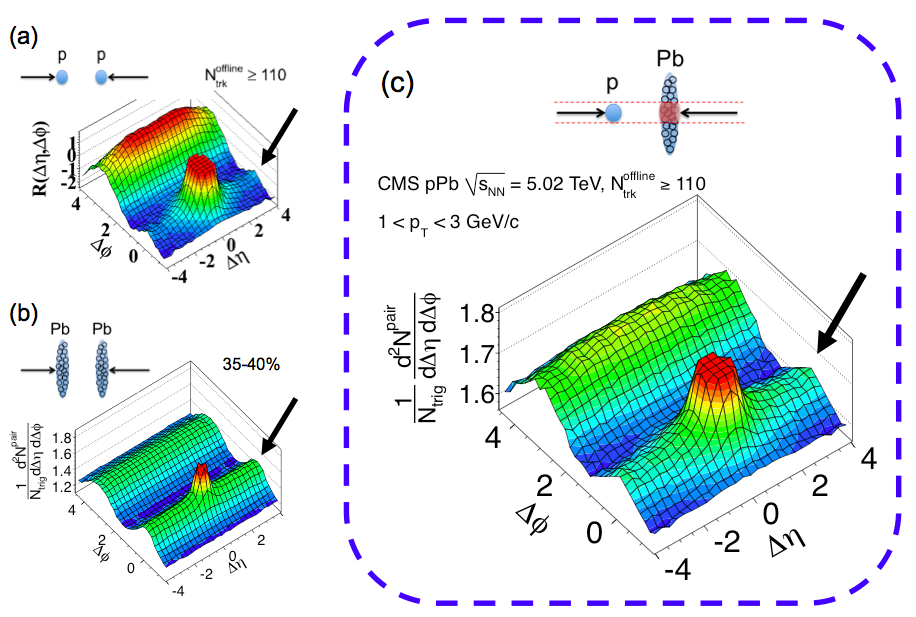
CMS has published its first paper on proton-lead (pPb) collisions, describing the observation of a phenomenon that was previously seen first in nucleus-nucleus collisions but also detected by CMS in proton-proton (pp) collisions. The effect is a correlation between pairs of particles formed in high-multiplicity collisions — that is, collisions producing a high number of particles — and manifests as a ridge-like structure. The ridges CMS observed in pp interactions, interactions of lead nuclei (PbPb) as well as those of pPb are shown in Figure 1.
Two-particle correlations in pp and PbPb collisions
In September 2010, CMS reported the observation of one of the first new effects at the LHC (JHEP 09 (2010) 091), seen in angular correlations of particles in proton-proton (pp) collisions: Once in about every 100,000 collisions with the highest produced particle multiplicity, an enhancement of particle pairs with small relative azimuthal angle Δφ was observed (Figure 1a). [Δφ is a measure of the angle between two tracks in the transverse plane. See Figure 3.] Such correlations had not been observed in pp collisions before, but were reminiscent of effects seen in nucleus-nucleus collisions at the Relativistic Heavy-Ion Collider (RHIC). The RHIC results were also later confirmed by CMS in lead-nuclei (PbPb) collisions at the LHC as well as by ALICE and ATLAS. Figure 1b shows the correlations seen by CMS in peripheral PbPb collisions.
Nucleus-nucleus collisions produce a hot, dense medium similar to the quark-gluon plasma (QGP) thought to have existed in the first microseconds after the big bang. The long-range correlations in PbPb collisions are interpreted as the result of a hydrodynamic expansion of this medium and are used to determine its fluid properties. Remarkably, this matter was found to flow better than any known form of matter with almost no frictional resistance, or viscosity, leading to the characterisation of the medium as a (nearly) perfect liquid.
Unlike in nucleus-nucleus collisions where the phenomenon is well explained and understood, the long-range correlation seen in pp collisions is a rather subtle effect, and, in order to be observable, requires among other criteria a dedicated trigger and beam conditions with at most a few concurrent interactions. As of now, none of the other LHC experiments have been able to confirm the CMS observation. Nonetheless, this result led to a wide large variety of theoretical models attempting to explain the origin of these so-called ridge-like correlations (see Mod. Phys. Lett. A27 (2012) 1230018 for a recent review).
Asymmetric collisions at the LHC
In September 2012, the LHC provided a short pilot run of pPb collisions, in preparation for a longer run in January 2013. During this run, the CMS experiment collected two million pPb collisions (compared to 150 billion collisions sampled for the pp correlation analysis). In pPb collisions an incoming proton can hit multiple nucleons inside the Pb nucleus, leading to a much larger average multiplicity of particles produced than in pp. This allowed a first study of particle correlations in the same multiplicity range as in pp with a much smaller data sample.
As long-range correlations are seen in both pp and PbPb collisions, it was natural to expect a possible effect also in pPb collisions. However, in pp data the correlations are only seen in very rare events where a single proton-proton collision results in a very high particle density. Therefore, with the expected magnitude of pPb correlations close to that in pp collisions, detecting the long-range ridge correlations in the small pPb sample seemed like a long shot.
Observation of the ridge
However, within a week of data-taking, the first correlation analysis of the pPb data had been performed — and revealed a long-range correlation ridge, as shown in Figure 1c. The observation was quickly confirmed with several independent analyses, followed by detailed comparisons to pp data and several models. As was the case for pp data, the most common pPb collision simulations do not show ridge-like correlations, thus indicating a new, still unexplained phenomenon.
The effect in pPb collisions is much stronger than in pp collisions. In fact it is comparable to that seen in PbPb collisions. The paper describing the new observation by CMS has been just submitted to Phys. Lett. B (arXiv:1210.5482).
The 2013 pPb run should yield at least a thousand-fold increase in the pPb data sample. Combined with the surprisingly large magnitude of the ridge seen by CMS, this will enable detailed correlation studies and open a new testing ground for basic questions in the physics of strongly interacting systems and the nature of the initial state of nuclear collisions.
— Submitted by Wei Li and Gunther Roland for the CMS Heavy Ions group.
- Log in to post comments

